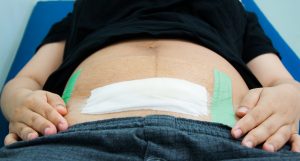The medical company Ethicon, Inc., a subsidiary of Johnson & Johnson, manufactures Proceed Hernia Meshes and Physiomesh Composite Meshes.
Ethicon manufactures two Proceed products: the Proceed Surgical Mesh (Proceed SM) and the Proceed Ventral Patch (Proceed VP). The Ventral patch is commonly used in hernia repair to provide structural support to the abdominal wall in hopes of preventing reoccurrence. Both products are laminate meshes comprised of a non-absorbable polypropylene mesh (Prolene) encapsulated by a polydioxanone polymer and a layer of absorbable oxidized regenerated cellulose (ORC).
The Proceed SM is a flat sheet of mesh while the Proceed VP is a round, self-expanding patch. Defects have plagued the product since its introduction.
Shortly after being introduced to the market, reports began flooding in from patients noting serious injuries as a result of having prolonged exposure to the mesh. The Proceed Surgical Mesh has been the subject of multiple recalls in 2006, 2010 and 2014. Recalls were issued because the structural integrity of the product was being compromised once implanted in patients.
The Proceed Ventral patch features a multi-layer construction. The base or structural layer is made of light polypropylene material. Throughout this site, you will notice polypropylene and issues from its use inside the human body are discussed multiple times. Most if not all hernia patches feature this plastic material which is notorious for causing problems.
The second layer of the patch is constructed from Oxidized Regenerated Cellulose (ORC). What is ORC?

Let’s start with cellulose. Cellulose is an organic carbohydrate and the main component in a plant’s cellular wall.
Tree trunks gain their strength and stability from the millions of cells that are composed of this material. As such, it makes sense to use this material as a means of providing support to openings in the abdominal wall.
The problem is the material must be synthetically manufactured so it can be absorbed by the human body. Ethicon uses a process that applies radiation to the patch, thus oxidizing the cellulose.
Oxidation of the patch allows the cellulose to become absorbable in the human body but weakens the polypropylene. Exposure to radiation causes the polypropylene fibers to break down over time.
Eventually, the patch tears, breaks off, or migrates inside the body causing a number of serious conditions. The most common issue, however, is the separation or delamination of the two layers.
Proceed Surgical Mesh Recall
A Proceed Surgical Mesh recall was issued for the delamination issue in 2006, 2010 and 2014. Although Ethicon issued these recalls, surgeons continue to find faulty, degraded patches in patients years after these notices.
The FDA continues to receive submissions through its MedWatch program. MedWatch is designed for consumers to report dangerous drugs and medical products. Below is just a small sample of the many submissions related to the Proceed mesh patch:
- Adverse Event – Material Separation
- Adverse Event – Material Separation (2)
- Adverse Event – Device Migration
These cases occurred within the last year and we expect to see more reported problems with this mesh.
In addition to delamination, the Proceed Surgical Mesh and Ventral Patch also have other notable flaws. The oxidation manufacturing process mentioned above breaks down the polypropylene material over time.
Proceed Mesh will also shrink and become brittle inside the patient’s body. Before long, they tear or break off and migrate inside the body. Some patients have undergone repeat operations to remove fragments of the mesh. Even worse, sometimes the broken pieces are never found!
Blowouts are another serious issue with this mesh patch. The Proceed SM and VP are made of a super-light polypropylene material designed to provide strength and flexibility.
Once the mesh begins degrading (sometimes in as little as 6 months) it becomes increasingly weak in the center. This can eventually lead to a known complication called a “blowout.”
A blowout is when the bowel punctures through the mesh and re-herniation occurs. This leads to intense pain and bowel strangulation.
Read more about other complications and side effects of hernia mesh.
Proceed Mesh Injuries
Injuries are widespread and range from minor pain to severe life-threatening complications.

Patients have reported cases of re-herniation as result of punctured or torn mesh patches. When the mesh is punctured, strangulation of the bowel occurs and additional surgery is required.
Other reported injuries include adhesion to internal organs, which occurs when contact is made with polypropylene. Once the ORC layer erodes, the polypropylene can bind directly to organs and tissue becoming very difficult to remove.
Bowel obstruction, infection and many of the other common hernia mesh complications have also been reported with the proceed patch. Again, many of these complications result from the use of the polypropylene material.
Proceed Mesh Settlements
Patients implanted with the Proceed Surgical Mesh or Proceed Ventral Patch should contact us today to determine eligibility. It’s possible that you may have been implanted with a recalled device. If you’re experiencing pain, or have undergone multiple operations to remove or repair the device, you may be eligible. Settlement amounts depend on the nature and details of your case.
More about surgical mesh settlements.
Injured by Hernia Mesh?
Contact us today to discuss a Claim for Compensation.
The consultation is always FREE.
To get started, simply click on the button below.
